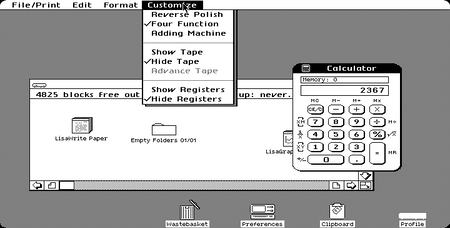Let’s pay a small tribute to a visual element that we almost never pay attention to, but that is already an integral part of our lives. Let’s talk about rounded corners.
They are everywhere and have taken over technology. We love them. We are full of devices and interfaces dominated by rectangles and squares with rounded corners. They are more elegant, softer to look at, much less aggressive and strident.
But there is a real psychology behind this way of designing objects and interfaces. For example: since we were little we always knew that sharp corners were dangerous – today corner protectors for children are a big deal. These elements facilitate visual perception, and their introduction into the technological world deserves to be remembered.
Steve Jobs was right (again)
Andy Hertzfeld was one of the members of the team that developed the Apple Macintosh. In May 1981 he shared a curious story, now recovered by the Computer History Museum.

Lisa OS 1.0. Look at the edges of the calculator app. They are rounded!
The protagonist of that story is Bill Atkinsonlegendary Apple engineer and Hertzfeld’s partner on that project. At that time Atkinson was working on the development of his QuickDraw application – then called LisaGraf – and although he usually worked from home, if he made any significant progress he would quickly go to the office to show off the improvement.
That’s what happened that spring. Atkinson approached Apple’s offices in the legendary “Texaco Towers” on the Cupertino campus and showed how he had added code to be able to draw circles and ovals very easily.
Programming that was much more complicated than it seems because square roots were usually involved to achieve it and the Motorola 68000 of the Lisa and the Macintosh did not support floating point operations.
Atkinson managed to solve it with calculations that only used addition and subtraction – he was probably inspired by Bresenham’s algorithm – and began filling the screen with circles and ovals while his classmates probably smiled in amazement and satisfaction. But there was someone who was neither too amazed nor too satisfied.
That someone was Steve Jobs. Upon seeing the demonstration, Jobs said
—Okay, circles and ovals are fine, but How about drawing rectangles with rounded corners? Can we do that too?
—No, there is no way to do it. “It would actually be really difficult to do, and I don’t really think we need it,” Atkinson replied, probably annoyed that Jobs hadn’t been too impressed with his method for creating circles and ovals.
—Rectangles with corners are everywhere! Look around this room!
Hello, Mac OS X with rounded corners (2001).
Sure enough, the room had objects like whiteboards and tables with rounded corners, and Jobs insisted that they were everywhere and that he only had to look out the window to notice.
He ended up convincing Atkinson to take him around the block and point out all the rectangles with rounded corners they saw. After seeing a no parking sign that was rectangular with rounded edges, he said:
—Okay, I give up. I’ll see if it’s as difficult as I thought.
And he went home to work on the problem. The next afternoon he returned to the office with a huge smile: his new demo I didn’t just draw rectangles with rounded cornersbut it did it almost as fast as it did drawing rectangles with corners. He added that code and called that primitive “RoundRects”.

In our pockets we usually carry a device that makes good use of these rectangles with rounded corners. The iPhone, of course, does it.
That design element soon became an integral and indispensable part of the Macintosh operating system interface. And it also ended up being part of the hardware (hello, mobile phones with rounded corners) and software design at both Apple and many other technology companies.

Source: Freepik.
The Cupertino firm also fully integrated it into its iPhones starting in 2013, when iOS 7 and its “squircle” arrivedan even more subtle type of rectangle with rounded corners that he ended up using, for example, in his icons. It was one more example of the particular relevance of a design element that has ended up completely taking over our screens and the technological world.
Long live the rounded corners.
In WorldOfSoftware | Many young people already see and hear everything at 1.5x. They didn’t get there by chance: there was a lot of money at stake
